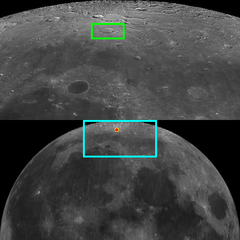Epigenes is a lunar impact crater that is located in the north part of the Moon, and is sufficiently close to the northern limb to appear significantly foreshortened from the Earth. It lies just to the northwest of the remains of the walled plain W. Bond. Due north of Epigenes is Goldschmidt, and the ruined crater Birmingham lies just to the southwest.
 Lunar Orbiter 4 image | |
| Coordinates | 67°30′N 4°36′W / 67.5°N 4.6°W |
|---|---|
| Diameter | 55 km |
| Depth | 2.0 km |
| Colongitude | 7° at sunrise |
| Eponym | Epigenes of Byzantium |


This formation is a picture in contrasts. The north and northwest parts of the rim are well-formed with little appearance of wear, while the remainder of the rim is notably eroded, particularly in the east-southeastern half. The western half of the interior floor is smooth and nearly featureless, while the remainder is somewhat hummocky and appears covered in ejecta from the east. The small crater Epigenes B intrudes into the northeastern rim.
Satellite craters
editBy convention these features are identified on lunar maps by placing the letter on the side of the crater midpoint that is closest to Epigenes.
| Epigenes | Latitude | Longitude | Diameter |
|---|---|---|---|
| A | 66.9° N | 0.3° W | 18 km |
| B | 68.3° N | 3.1° W | 11 km |
| D | 68.3° N | 0.3° E | 10 km |
| F | 67.1° N | 8.1° W | 5 km |
| G | 68.9° N | 7.0° W | 5 km |
| H | 69.4° N | 6.4° W | 7 km |
| P | 65.4° N | 5.4° W | 33 km |
References
edit- ^ The geologic history of the Moon. USGS Professional Paper 1348. By Don E. Wilhelms, John F. McCauley, and Newell J. Trask. U.S. Government Printing Office, Washington: 1987. Table 9-4.
- Andersson, L. E.; Whitaker, E. A. (1982). NASA Catalogue of Lunar Nomenclature. NASA RP-1097.
- Blue, Jennifer (July 25, 2007). "Gazetteer of Planetary Nomenclature". USGS. Retrieved 2007-08-05.
- Bussey, B.; Spudis, P. (2004). The Clementine Atlas of the Moon. New York: Cambridge University Press. ISBN 978-0-521-81528-4.
- Cocks, Elijah E.; Cocks, Josiah C. (1995). Who's Who on the Moon: A Biographical Dictionary of Lunar Nomenclature. Tudor Publishers. ISBN 978-0-936389-27-1.
- McDowell, Jonathan (July 15, 2007). "Lunar Nomenclature". Jonathan's Space Report. Retrieved 2007-10-24.
- Menzel, D. H.; Minnaert, M.; Levin, B.; Dollfus, A.; Bell, B. (1971). "Report on Lunar Nomenclature by the Working Group of Commission 17 of the IAU". Space Science Reviews. 12 (2): 136–186. Bibcode:1971SSRv...12..136M. doi:10.1007/BF00171763. S2CID 122125855.
- Moore, Patrick (2001). On the Moon. Sterling Publishing Co. ISBN 978-0-304-35469-6.
- Price, Fred W. (1988). The Moon Observer's Handbook. Cambridge University Press. ISBN 978-0-521-33500-3.
- Rükl, Antonín (1990). Atlas of the Moon. Kalmbach Books. ISBN 978-0-913135-17-4.
- Webb, Rev. T. W. (1962). Celestial Objects for Common Telescopes (6th revised ed.). Dover. ISBN 978-0-486-20917-3.
- Whitaker, Ewen A. (1999). Mapping and Naming the Moon. Cambridge University Press. ISBN 978-0-521-62248-6.
- Wlasuk, Peter T. (2000). Observing the Moon. Springer. ISBN 978-1-85233-193-1.